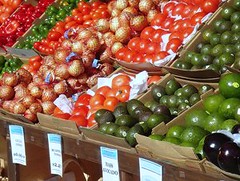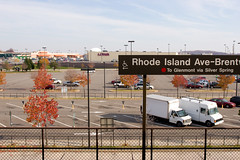A local lesson in transit orientation, walkability and supermarket economics

Posted March 8, 2010 at 1:33PM
Several weeks ago, I ran a post making the case that transit-oriented development requires more than just transit and development. As the phrase implies, it also requires orientation: the development must relate to and be convenient to the transit. There is also a body of practice and research on the closely linked subject of walkable neighborhoods, which require more than just sidewalks and places you might want to go within theoretical walking distance. This recently posted and very good presentation by the Washington, DC Office of Planning, for example, outlines (among other things) some of the elements of city fabric that make communities hospitable to walking.
 Now the northeast DC neighborhood of Edgewood is experiencing some hard lessons about both transit orientation and walkability. First, it is losing its Safeway supermarket at least partly because of the store's failure to attract business from a nearby Metro rail transit station; second, residents literally on the wrong side of the tracks are being left with a difficult walking environment to reach what will now be their closest alternative market.
Now the northeast DC neighborhood of Edgewood is experiencing some hard lessons about both transit orientation and walkability. First, it is losing its Safeway supermarket at least partly because of the store's failure to attract business from a nearby Metro rail transit station; second, residents literally on the wrong side of the tracks are being left with a difficult walking environment to reach what will now be their closest alternative market.
In particular, a competing Giant supermarket is a bit farther away from the Metro station than the Safeway site, but the Giant has succeeded while the Safeway hasn't. The Giant apparently has captured more business from Metro riders because it is on the same side of Rhode Island Avenue, a wide and busy thoroughfare that walkers are reluctant to cross if they don’t have to. Craig Muckle, an official for the Safeway chain, told Washington Post writer Hamil R. Harris that the Edgewood Safeway had been unprofitable for a decade: "While we are closer to the Metro, the Giant is more convenient for people coming off the Metro, and it is located in a plaza that is frankly more vibrant."
On the Google Earth image above, you can see the location of the Safeway in red, the Giant in yellow, and the Metro station in green. Looking at the image, the loss of the Safeway seems particularly unfortunate because it is the less automobile-oriented of the two stores and, were it not for the barriers of Rhode Island Avenue (running diagonally southwest to northeast) and the Metro tracks (running more north-south), within walking reach of more homes.
The loss of the store will be particularly hard for residents of affordably priced apartments at Edgewood Terrace, the complex outlined in fuchsia above (see also photos below), many of whom do not drive and some of whom are seniors. They have been the Safeway's nearest and most loyal customers. Walking to the Giant will not only be a longer distance (four blocks instead of next door) and involve crossing the busy street and Metro tracks; it will also entail walking up and down two steep hills (accessed with concrete steps) with their groceries on the round trip. Relative accessibility is about more than mere distance to shops and services.
Hamil interviewed longtime DC city council member Harry Thomas, who believes the Safeway didn’t do enough to stay competitive:
"’Rhode Island Avenue is a great location. It has tremendous opportunities and is adjacent to the Metro,’ Thomas said. ‘But Safeway didn't rise to the challenge. They really didn't make enough investments to that store, and residents deserved better.’
“On Monday night, Thomas and Ward 5 community leaders met to discuss long-term development plans for the Rhode Island Avenue corridor. Thomas said the sentiment among members of the group is that a store in the order of a Giant or Whole Foods should fill the site once Safeway is gone.
"’We want a quality business in there," he said.”
 I hope they get it. The paucity of convenient access to healthy food, particularly fresh produce, in less affluent and working-class neighborhoods like Edgewood is a matter of both local and national concern.
I hope they get it. The paucity of convenient access to healthy food, particularly fresh produce, in less affluent and working-class neighborhoods like Edgewood is a matter of both local and national concern.
It may be, however, that the area around the Metro station just doesn't contain enough potential customers to support two full-service supermarkets, particularly in such close proximity to each other. The Safeway site may be more suited to a specialty market than a supermarket, which still could allow residents on the northwest side of Rhode Island Avenue and the Metro tracks to meet at least some of their shopping needs without the difficult walk to the Giant. Streetscape improvements to calm traffic and make crossing the Avenue and tracks more convenient for pedestrians would bring additional help.
Both supermarket sites are within a zone that is under study "to transform the land uses along the [Rhose Island Avenue] corridor into a series of well-defined, pedestrian-friendly neighborhood centers while preserving and enhancing the quality of life of the diverse, existing neighborhoods abutting it."
This is a good thing. Even the Giant, though apparently more popular with Metro riders, is certainly not what any urbanist would call "transit-oriented." I believe that, over time, the large parking lots adjacent to and around the Giant and Metro (see photos) - which now serve a number of suburban-style commercial outlets as well as the Metro station - will develop in a more urban and transit-oriented way. Those sites would seem ideal for multifamily homes and mixed-use commercial development, perhaps moving an appropriate amount of parking underground. This will put more residents close to the Metro station and allow the supermarket and other commercial businesses on the southeast side of Metro to serve more customers on foot.
For now, unfortunately, there remains unfulfilled potential on both sides of the transit station. Here’s a short video on the Safeway’s closing that accompanied the Post story:




